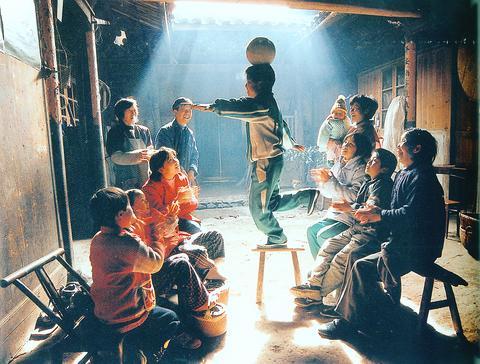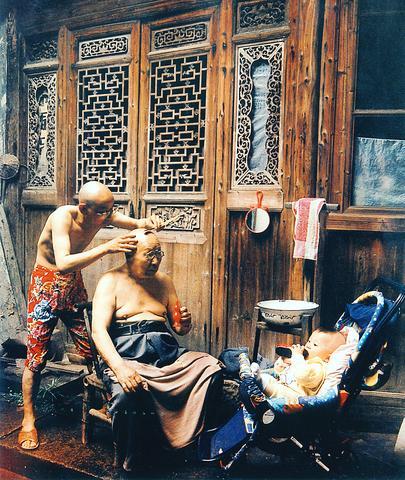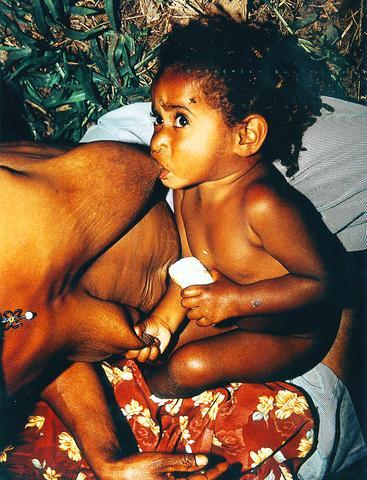The annual "Love of the Millennium" photography competition(
The competition was jointly organized by Taiwan's Uni-President Enterprises Corp. (

PHOTO COURTESY OF LOVE OF THE MILLENNIUM
The works from the 80 winners are currently on show in The 2004 Invitational Joint Exhibition by the Photographers from the Two Sides of the Taiwan Strait, (

PHOTO COURTESY OF LOVE OF THE MILLENNIUM
Daily life in small villages in western China seem to be a favorite topic of the participants. Some of the most lingering images of the show are of rural families enjoying themselves amid adverse living conditions -- as people give free rein to their emotions at weddings or the Lunar New Year.
The US$3,000 gold prize fell to Geng Yu-sheng (

PHOTO COURTESY OF LOVE OF THE MILLENNIUM
"It was such a touching scene of the harmonious relations between human beings, animals and nature, that I couldn't help clicking the shutter again and again. I took over 10 pictures of it," Geng said.
Their First Joint Portrait (
Although the winners do not all show the same technical level -- and there are some works of trite composition and vague messages -- their observation of real emotions and happiness, even in the unlikeliest places, gives viewers a happy experience.
The invitational part of the exhibition is the place to see the works of Taiwanese and Chinese photographers active in their respective photography circles. Lin Zai-sheng's (
The 2004 Invitational Joint Exhibition by Photographers from the Two Sides of the Taiwan Strait runs through Jan. 25 at the National Museum of History, 49 Nanhai Rd, Taipei (台北市南海路49號).

The canonical shot of an East Asian city is a night skyline studded with towering apartment and office buildings, bright with neon and plastic signage, a landscape of energy and modernity. Another classic image is the same city seen from above, in which identical apartment towers march across the city, spilling out over nearby geography, like stylized soldiers colonizing new territory in a board game. Densely populated dynamic conurbations of money, technological innovation and convenience, it is hard to see the cities of East Asia as what they truly are: necropolises. Why is this? The East Asian development model, with

June 16 to June 22 The following flyer appeared on the streets of Hsinchu on June 12, 1895: “Taipei has already fallen to the Japanese barbarians, who have brought great misery to our land and people. We heard that the Japanese occupiers will tax our gardens, our houses, our bodies, and even our chickens, dogs, cows and pigs. They wear their hair wild, carve their teeth, tattoo their foreheads, wear strange clothes and speak a strange language. How can we be ruled by such people?” Posted by civilian militia leader Wu Tang-hsing (吳湯興), it was a call to arms to retake

This is a deeply unsettling period in Taiwan. Uncertainties are everywhere while everyone waits for a small army of other shoes to drop on nearly every front. During challenging times, interesting political changes can happen, yet all three major political parties are beset with scandals, strife and self-inflicted wounds. As the ruling party, the Democratic Progressive Party (DPP) is held accountable for not only the challenges to the party, but also the nation. Taiwan is geopolitically and economically under threat. Domestically, the administration is under siege by the opposition-controlled legislature and growing discontent with what opponents characterize as arrogant, autocratic

Desperate dads meet in car parks to exchange packets; exhausted parents slip it into their kids’ drinks; families wait months for prescriptions buy it “off label.” But is it worth the risk? “The first time I gave him a gummy, I thought, ‘Oh my God, have I killed him?’ He just passed out in front of the TV. That never happens.” Jen remembers giving her son, David, six, melatonin to help him sleep. She got them from a friend, a pediatrician who gave them to her own child. “It was sort of hilarious. She had half a tub of gummies,